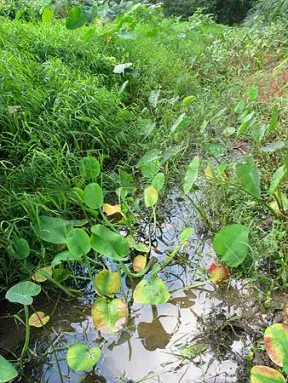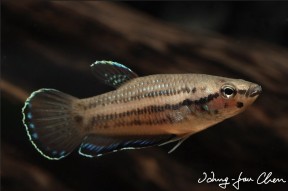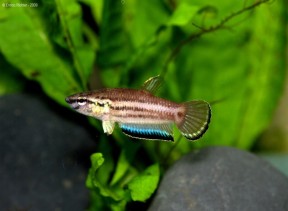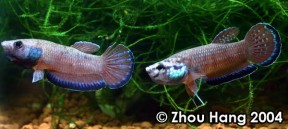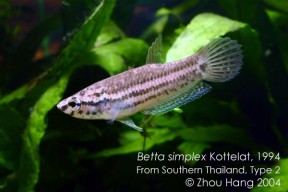Betta simplex
Etymology
Betta: from ikan betah, the vernacular Malay for species of this genus.
simplex: from the Latin simplex, meaning ‘simple, plain’.
Classification
Order: Perciformes Family: Osphronemidae
Distribution
Known only from Krabi province, southern (peninsular) Thailand. Several populations exist, including one close to Ao Luek that has appeared in the aquarium hobby as B. simplex ‘type 2’ (see images).
Type locality is ‘Thailand: Krabi Province: northwest of Krabi, springs (small lake) of Tham Sra Kaew and Nine Ponds, behind Ban Nai Sra village, 2.2 km from National Highway 4034, 1800 m behind Public Health Centre’.
Habitat
This species’ habitats are located in a karstic area and contain neutral to alkaline water with a pH of 7.0-7.4.
The type locality consists of a series of deep limestone sinkholes forming pools at the surface, plus a small ditch which acts as an overflow from the pools. The water is very clear and has a distinctive bright blue-green colour due to the high proportion of dissolved calcium carbonate.
According to reports B. simplex is most abundant in the small ditch draining the pools. This often drys out with some of the fish surviving in shallow remnant pools for part of the year. Marginal vegetation grows densely around the ditch although aquatic vegetation is mainly confined to the pools where large beds of Cryptocoryne cordata can be found. Sympatric species in the pool system include Barbodes lateristriga and Trigonostigma espei.
The Ao Luek population inhabits a flowing stream with limestone rocks and gravel, overhanging marginal vegetation, and clear water. Channa lucius and a Danio sp. were also recorded there.
Maximum Standard Length
45 – 60 mm.
Aquarium SizeTop ↑
An aquarium with base measurements of 60 ∗ 30 cm should be the minimum considered but is suitable for a pair or small group.
Maintenance
This species does best in a well-planted, shady aquarium with plenty of surface cover in the form of tall stem plants, floating types such as Salvinia or Riccia spp., or tropical lilies from the genus Nymphaea. Cryptocoryne spp. are also a good choice.
Driftwood can also be used and other plants such as Microsorum or Taxiphyllum spp. may be attached to it. Small clay plant pots, lengths of plastic piping or empty camera film cases can also be included to provide further shelter.
The addition of dried leaf litter offers additional cover and brings with it the growth of microbe colonies as decomposition occurs. These can provide a valuable secondary food source for fry, while tannins and other chemicals released by the decaying leaves are considered beneficial.
As it naturally inhabits sluggish environments strong water movement should be avoided, with an air-powered sponge filter set to turn over gently adequate. Keep the aquarium well-covered and do not fill it to the top since like all Betta spp. it requires occasional access to the layer of humid air that will form above the water surface, and is an excellent jumper.
Water Conditions
Temperature: 20 – 28 °C
pH: 7.0 – 8.0
Hardness: 54 – 215 ppm
Diet
Likely to prey on aquatic and terrestrial invertebrates in nature.
Captive fish will normally accept dried products once they are recognised as edible, but should be offered plenty of small live or frozen foods such as Daphnia, Artemia or chironomid larvae (bloodworm) regularly to ensure development of optimal colour and condition.
Take care not to overfeed as Betta spp. seem particularly prone to obesity.
Behaviour and CompatibilityTop ↑
Not recommended for the standard community aquarium. Its care requirements and disposition mean it is best kept alone or with very peaceful species. Some small cyprinids and loaches that inhabit similar environments in nature are suitable, but proper research prior to purchase is essential and in most cases it is best maintained alone.
It is not among the more aggressive members of the genus and can be maintained in a pair or group.
Sexual Dimorphism
Males grow larger, possess a greater extent of iridescent scaling on the head, a broader head shape, and more extended fins than females.
Reproduction
Paternal mouthbrooder. Ideally organise a separate aquarium for breeding purposes, unless the fish are already being maintained alone.
The aquarium should have the tightest-fitting cover possible (some breeders use clingfilm/plastic wrap) because the fry need access to a layer of warm, humid air without which development of the labyrinth organ can be impaired.
Following a protracted courtship, eggs and milt are released during an ’embrace’ typical of osphronemids, with the male wrapped around the female. Several ‘dummy’ embraces may be required before spawning commences.
Fertilised eggs are caught on the anal fin of the male then picked up in the mouth of the female before being spat out into the water for the male to catch. Once the male has all the eggs in his mouth the process is repeated until the female is spent of eggs, a process which can take some time.
A brooding male may swallow or release the eggs prematurely if stressed or inexperienced, so it is preferable to leave the female and any other fishes in situ. The incubation period is 9-16 days, after which the male will begin to release free-swimming fry. Apparently the adults do not harm them and some breeders have reported them to develop at a faster rate when left with the parents.
The fry are large enough to accept motile foods such as microworm and Artemia nauplii immediately, though it should be noted that there exist reports of young Betta developing health issues if fed excessive amounts of the latter. Water changes should be small and regular rather than large and intermittent.
NotesTop ↑
B. simplex is included in the Betta picta group/complex of closely-related species within the genus, an assemblage comprising species with the following shared characters: unpaired fins rounded (anal-fin sometimes tapering to a blunt point); anal-fin rays I-III, 18-24; dark marginal band on anal and caudal fins, more pronounced in mature males; presence of pre- and post-orbital stripes; presence of chin bar on throat; iridescent green, gold, or blue scales on opercle.
The unique combination of characters distinguishing B. simplex from others in the group is as follows: presence of greenish blue iridescent opercular scales; chin bar indistinct; body and fins pale reddish; head dark reddish; male without iridescent scales on body; 23-24 anal-fin rays (mode 24); 9.5-11.5 transverse scales (mode 11.5); predorsal length 66.7-69.8 % SL; head length 34.6-37.2 % SL; body depth 29.3-32.2 % SL.
The genus Betta is the most speciose within the family Osphronemidae. Members have successfully adapted to inhabit a variety of ecological niches from stagnant ditches to flowing hill streams including some extreme environments such as highly acidic peat swamp forests.
The referral of members to a number of groups containing closely-related species is largely based on morphological and behavioural characters. A full list of the species groups as currently recognised can be found here.
Like others in the suborder Anabantoidei this species possesses an accessory breathing organ known as the labyrinth, which permits the fish to breathe atmospheric air to a certain extent. Comprising paired suprabranchial organs formed via expansion of the epibranchial (upper) section of the first gill arch and housed in a chamber above the gills, it contains many highly-vascularised, folded flaps of skin which function as a large respiratory surface. Its structure varies in complexity between species, tending to be more developed in those inhabiting harsher environments.
References
- Kottelat, M., 1994 - Ichthyological Exploration of Freshwaters 5(4): 297-304
Diagnoses of two new species of fighting fishes from Thailand and Cambodia (Teleostei: Belontiidae). - Armitage, D., 2007 - Aquarium Fish International 19.10: 64-70
A fish fellowship goes to Thailand. - Kottelat, M., 2013 - Raffles Bulletin of Zoology Supplement 27: 1-663
The fishes of the inland waters of southeast Asia: a catalogue and core bibiography of the fishes known to occur in freshwaters, mangroves and estuaries. - Schindler, I. and J. Schmidt, 2006 - Zeitschrift für Fischkunde 8(1/2): 47-69
Review of the mouthbrooding Betta (Teleostei, Osphronemidae) from Thailand, with descriptions of two new species. - Tan, H. H. and P. K. L. Ng, 2005 - Raffles Bulletin of Zoology Supplement (13): 43-99
The fighting fishes (Teleostei: Osphronemidae: Genus Betta) of Singapore, Malaysia and Brunei. - Witte, K.-E. and J. Schmidt, 1992 - Ichthyological Exploration of Freshwaters 2(4): 305-330
Betta brownorum, a new species of anabantoids (Teleostei: Belontiidae) from northwestern Borneo, with a key to the genus.




